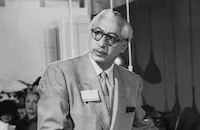Marianne

Brief Synopsis
Cast & Crew
Robert Z. Leonard
George Baxter
Lawrence Gray
Cliff Edwards
Benny Rubin
Scott Kolk
Film Details
Technical Specs

Synopsis
Marianne, a fresh and bubbly French heroine, runs an inn and also a nursery in a small French town during the World War. Separated from her childhood sweetheart, André, she promises to wait for him. Her town is partially destroyed, and a company of American soldiers is quartered there, awaiting orders to return home. Fond of a pig about to be slaughtered, Marianne claims it as a pet and goes through much to save it from becoming bacon, in the process captivating Private Stagg, who is put in the stockade for trying to rescue the porcine object of her affections from a ravenous lieutenant. Marianne and Stagg fall in love but are reconciled to parting when André returns home blinded, and Stagg ships off for home. She soon perceives that André is in love with his nurse and, gathering up her quartet of war orphans, leaves for America and her man.

Director

Robert Z. Leonard
Cast
George Baxter

Lawrence Gray

Cliff Edwards

Benny Rubin
Scott Kolk

Robert Edeson
Emil Chautard
Oscar Shaw
Robert Castle

Robert Ames

Mack Swain
Oscar Apfel
Crew
Adrian
Fred E. Alhert
Nacio Herb Brown
Joe Farnham
Arthur Freed
Cedric Gibbons
Jesse Greer
Ray Klages
Oliver Marsh
Ralph Shugart
Roy Turk
Dale Van Every
Basil Wrangell

Videos
Movie Clip



Hosted Intro
Film Details
Technical Specs

Articles
Marianne
Davies plays a sweet, vivacious French girl whose childhood sweetheart and intended husband is missing in action. A company of American soldiers is quartered in the village where Marianne runs an inn and cares for orphans, and she soon finds herself falling for Pvt. Stagg, a doughboy who lands in the brig after his gallant attempt to save her pet pig. When her French sweetheart shows up, circumstances take a turn that allows Marianne to start a new life.
Marianne was inspired by King Vidor's epic World War I hit The Big Parade (1925). Davies's lover and patron, William Randolph Hearst, wanted to ensure the quality of her picture by hiring Laurence Stallings, the writer of that earlier war film as well as Davies's acclaimed comedy Show People (1928), to help craft the screenplay.
Davies's costar in the silent version, Oscar Shaw, was a veteran of Broadway musicals, but, oddly enough, he was replaced by Lawrence Gray in the sound version. Gray had appeared with Davies in one of her biggest hits, The Patsy (1928), and would act opposite her again in The Florodora Girl (1930). Davies found him very easy to work with, although she later related a story about his hot temper exploding after he burned his costume uniform jacket by setting it on a curling iron a hairdresser had left on the set.
The star herself incurred the anger of MGM production chief Irving Thalberg during the filming of Marianne. The company had been given use of an orchestra for three hours to record a musical number that they finished in two hours. So she suggested throwing in another number, one that Thalberg had already decided should be cut from the movie, and it was recorded on the spot. Thalberg fumed when he found out, but later apologized and relented on leaving the number in the movie. Marianne also produced a lasting hit in the tune "Just You, Just Me."
Davies's actual sound debut was a brief song-and-dance appearance in the all-star The Hollywood Revue of 1929 (1929), released just ten days prior to Marianne and featuring the star as herself.
Director: Robert Z. Leonard
Producers: Marion Davies, Robert Z. Leonard
Screenplay: Laurence Stallings, Gladys Unger, story by Dale Van Every
Cinematography: Oliver T. Marsh
Editing: James McKay
Art Direction: Cedric Gibbons
Original Music: William Axt, Charles Maxwell (both uncredited) Cast: Marion Davies (Marianne), Lawrence Gray (Pvt. Stagg), Cliff Edwards (Soapy Soapstone), Benny Rubin (Sammy Samuels), George Baxter (Andre).
BW-111m.
by Rob Nixon















